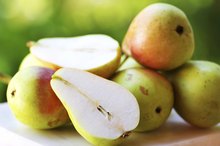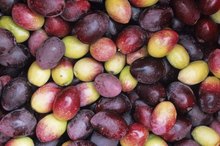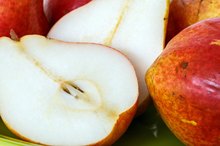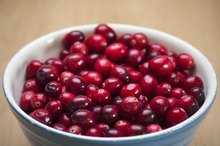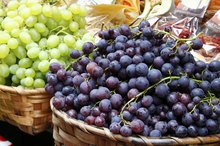What does fact checked mean?
At Healthfully, we strive to deliver objective content that is accurate and up-to-date. Our team periodically reviews articles in order to ensure content quality. The sources cited below consist of evidence from peer-reviewed journals, prominent medical organizations, academic associations, and government data.
- Medline Plus: Vitamin K
- "Nutrition Reviews"; Biomedical Effects of Grape Products; L.M. Vislocky, et al.; November 2010
- "Nutrition Reviews"; Biomedical Effects of Grape Products; L.M. Vislocky, et al.; November 2010
The information contained on this site is for informational purposes only, and should not be used as a substitute for the advice of a professional health care provider. Please check with the appropriate physician regarding health questions and concerns. Although we strive to deliver accurate and up-to-date information, no guarantee to that effect is made.
Do Grapes Have Vitamin K?
Grapes have been cultivated since biblical times and are still a favorite snack fruit. Sweet to taste, they are often used to satisfy sugar cravings, and with more than 50 varieties, you are sure to find a type that you like. Loaded with vitamins and minerals, consuming grapes contributes to your daily intake of necessary compounds. Of the vitamins found in grapes, vitamin K is predominant, but they also deliver other nutritional benefits.
Vitamin K Content
The USDA National Nutrient Database reports that 1 cup of red or green grapes contains 22 mcg of vitamin K, which is 28 percent of the recommended daily intake 2. The primary function of vitamin K in the body is to clot the blood, and without it, you may bleed to death with even a small incision or cut. The National Institutes of Health reports that vitamin K also may play a role in the building of healthy bones. Because of its blood-thinning action, if you are on blood thinners speak to your physician before eating foods high in vitamin K.
- The USDA National Nutrient Database reports that 1 cup of red or green grapes contains 22 mcg of vitamin K, which is 28 percent of the recommended daily intake 2.
- The primary function of vitamin K in the body is to clot the blood, and without it, you may bleed to death with even a small incision or cut.
Vitamin C and Minerals
What Vitamins Do Mangoes Have?
Learn More
When you think of fruits high in vitamin C, oranges and grapefruit may spring to mind, but grapes contain a high amount of vitamin C as well. The 1-cup serving that offers 28 percent of the RDI of vitamin K delivers 27 percent of the recommended vitamin C intake, with 16.3 mg. Vitamin C is a water-soluble vitamin, which means it is not stored in the body and needs to be replaced daily. Functions of vitamin C include building up of the immune system and the building and maintenance of healthy bones, teeth, skin and membranes. Grapes contain other vitamins, although none in a concentration as high as vitamin K. Other vitamins include vitamin A, vitamin E and the B complex. Along with vitamins, grapes contain several minerals, including copper, potassium, phosphorous, magnesium, iron, manganese, calcium, zinc, selenium and fluoride.
- When you think of fruits high in vitamin C, oranges and grapefruit may spring to mind, but grapes contain a high amount of vitamin C as well.
- Vitamin C is a water-soluble vitamin, which means it is not stored in the body and needs to be replaced daily.
Diet Profile
Grapes provide more than vitamins and minerals. The 1-cup serving of red or green grapes offers 27.3 g of carbohydrate, 23.4 g of which are sugars with 1.4 g of fiber. Protein at 1.1 g, 104 calories and 0.2 g of fat round out the dietary profile of grapes.
Health Benefits
How Many Calories Does a Pear Have?
Learn More
The vitamins and minerals in grapes provide their own specific health benefits, but grapes, particularly red ones, contain other compounds that offer even more. Grape skins, seeds and pulp contain polyphenols and antioxidant compounds, such as resveratrol, that help fight chronic diseases. The November 2010 issue of "Nutrition Reviews" reports that grapes help fight and decrease the risk of heart disease, cancer, diabetes, Alzheimer's and hardening of the arteries.
Related Articles
References
- Centers for Disease Control: Fruit of the Month: Grapes
- USDA: National Nutrient Database: Keyword: Grapes
- Medline Plus: Vitamin K
- "Nutrition Reviews"; Biomedical Effects of Grape Products; L.M. Vislocky, et al.; November 2010
- Guerrero RF, García-Parrilla MC, Puertas B, Cantos-Villar E. Wine, resveratrol and health: A review. Nat Prod Commun. 2009;4(5):635-58.
- Grapes, American type, raw. FoodData Central. U.S. Department of Agriculture. Published April 1, 2019.
- Atkinson FS, Foster-Powell K, Brand-Miller JC. International tables of glycemic index and glycemic load values: 2008. Diabetes Care. 2008;31(12):2281-3. doi:10.2337/dc08-1239
- Tomé-Carneiro J, Larrosa M, Yáñez-Gascón MJ, et al. One-year supplementation with a grape extract containing resveratrol modulates inflammatory-related microRNAs and cytokines expression in peripheral blood mononuclear cells of type 2 diabetes and hypertensive patients with coronary artery disease. Pharmacol Res. 2013;72:69-82. doi:10.1016/j.phrs.2013.03.011
- Russo M, Spagnuolo C, Tedesco I, Bilotto S, Russo GL. The flavonoid quercetin in disease prevention and therapy: Facts and fancies. Biochem Pharmacol. 2012;83(1):6-15. doi:10.1016/j.bcp.2011.08.010
- Pasinetti GM, Wang J, Ho L, Zhao W, Dubner L. Roles of resveratrol and other grape-derived polyphenols in Alzheimer's disease prevention and treatment. Biochim Biophys Acta. 2015;1852(6):1202-8. doi:10.1016/j.bbadis.2014.10.006
- Szkudelski T, Szkudelska K. Resveratrol and diabetes: from animal to human studies. Biochim Biophys Acta. 2015;1852(6):1145-54. doi:10.1016/j.bbadis.2014.10.013
- American Academy of Allergy Asthma and Immunology. Anaphylactic actions to cherries, strawberries, and grapes. Updated April 12, 2018.
- Berkeley Wellness, University of California. Types of grapes. Updated July 10, 2015.
- Grape juice, 100%. FoodData Central. U.S. Department of Agriculture. Published April 1, 2019.
- Consumer Reports. Is the cloudy coating on blueberries safe to eat?. Updated May 17, 2010.
Resources
Writer Bio
A certified nutritionist who majored in health, fitness and nutrition, Traci Vandermark has been writing articles in her specialty fields since 1998. Her articles have appeared both online and in print for publications such as Simple Abundance, "Catskill Country Magazine," "Birds and Blooms," "Cappers" and "Country Discoveries."

